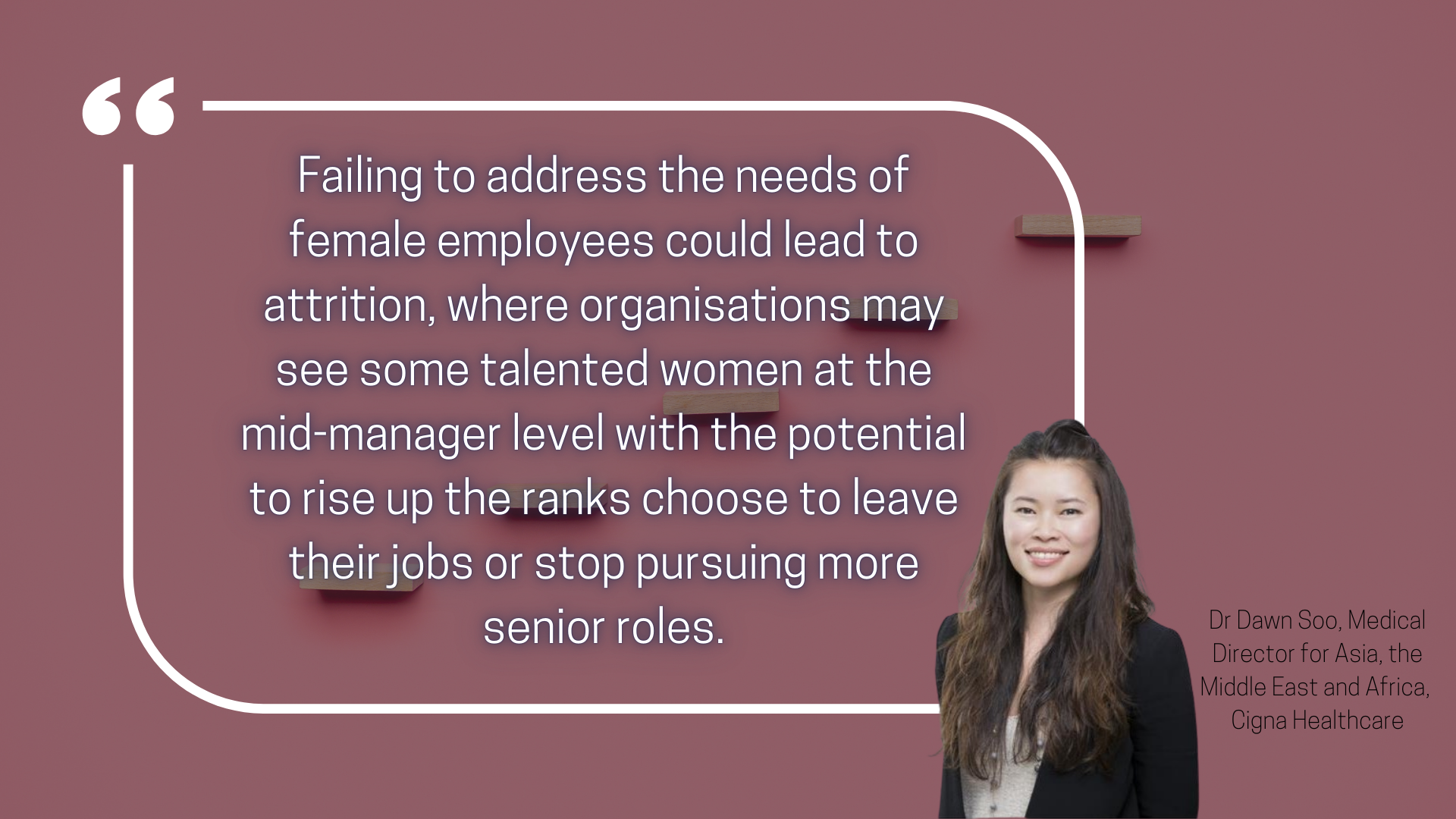Middle management crucial to empowering women’s health at work
- HRM Asia Newsroom

Many of us in the workforce engage in something called the ‘second shift’ – the unpaid domestic work that starts when a person’s official workday ends. Oftentimes, it is women who take the brunt of this work, and as we strive to juggle between family duties and our day jobs, we may find our own health and wellbeing being compromised.
The Cigna Healthcare International Health Study measures the level of vitality among respondents, which is an individual’s ability to pursue life with health, strength, and energy based on their responses about eight dimensions of health. In the 2024 study, female employees in Singapore reported a lower vitality score of 59.6 compared to 64.3 for male employees, indicating poorer overall wellbeing among women.
The study also revealed that female employees experience more stress than men – 84% of female employees reported feeling stress, compared to 78% of male employees. When we look at the source of stress, 10% more working women than men get stressed about their relationships with people, including family members, friends and others.
I believe this may explain why we sometimes feel reluctant to take the time to take care of ourselves – we fear that by doing so, we are letting our co-workers or family down, or we do not want to inconvenience others and put stress on our relationships with them by asking for their help.
Women more likely to need and seek medical support
At Cigna Healthcare Singapore, we see that insurance claims by women for anxiety disorders and adjustment disorders, which are short-term mental health issues related to changes in life, are almost double that of men.
When it comes to physical health, although there are no major differences in issues reported by males and females, aside from maternity and childbirth-related issues in females, it is important to note that mental health issues can manifest as physical symptoms. Some of these symptoms include musculoskeletal issues, palpitations, and gastrointestinal symptoms, among others.
While claim numbers are partly affected by differences in people’s likelihood to seek medical help, the large differences in mental health claims between males and females could indicate that women are more prone to feeling burdened and suffering from poor health as a result.
There’s not enough talk about fertility and maternal health issues
Planning for a family is a big change in a woman’s life. While exciting, it can also come with stress and challenges from the time before conception to pregnancy and the postpartum period.
Women who have just returned to the workforce after their maternity leave might feel bad for needing additional time off to navigate motherhood or feel pressured to quickly readjust to the workplace, which may consequently exert a further psychological toll on them. As a mother of two, I have experienced this when I started taking work calls towards the end of my maternity leave because I felt bad about being away for so long.
Postpartum blues and depression affect between 7-10% of women, according to the Ministry of Health Singapore, and have clear associations with adverse outcomes in both mother and child if not managed appropriately. Yet, most women are uncomfortable talking about it, even less so within the workplace.
On the other hand, gynaecological health conditions such as endometriosis and uterine fibroids are not uncommon in women of reproductive age. Yet they are rarely reported at the workplace. Often, these issues come with seemingly ordinary symptoms such as menstrual cramps or a particularly heavy period. Therefore, many women might brush them off or refrain from getting them checked out, thinking they might not be considered legitimate reasons for taking time off to do so. These issues then manifest as fertility issues when they begin family planning later in their lives.
More time and resources might be invested into addressing these problems by then. Fertility treatments like intrauterine insemination and in vitro fertilisation typically involve multiple doctor’s appointments every week and can take months to complete, depending on the issues involved. Having to ask for time off from work to do this, particularly in the Asian context where fertility issues are less commonly discussed, could prove stressful for many.
Health issues being a potential roadblock for career success
It is crucial for organisations to understand the differences between male and female employees’ behaviour at work due to changes in their physical and mental health, with female employees more likely to face difficulty performing their work and accomplish less than their usual at work. Looking at employees in Singapore, our research found that 36% of female employees reported they accomplished less than usual at work due to changes in their mental health, compared to 28% of male employees.
Failing to address the needs of female employees could lead to attrition, where organisations may see some talented women at the mid-manager level with the potential to rise up the ranks choose to leave their jobs or stop pursuing more senior roles.
One subset of employees at risk of attrition are females undergoing menopause. Research in Japan revealed that around one-fifth of women in their 40s and 50s quit the workforce because of menopause symptoms every year. Meanwhile, a similar study in the UK found that the proportion of women considering quitting for the same reason was 23%.
Middle management plays a crucial role
Retaining the best and brightest women at work does not always involve heavy investment in training and development or large-scale campaigns. What we need is an organisational mindset that prioritises employee wellbeing. When supporting women through major life changes, employers should recognise that there are critical months when additional workplace support could make a huge difference.
One segment of leaders that is key to this shift in mindset is middle management. Having middle management, those who directly manage employees and interact most often with them, understand and be comfortable talking about women’s health topics or at least know where to direct women to for support correctly, is a big step towards encouraging open conversation and destigmatising talking about women’s health issues at work. To facilitate women to take time off to address health, family or personal matters, managers also need to ensure that there is appropriate workforce cover when employees need to go on leave so that they can truly focus on their wellbeing.
This understanding could be enhanced through training, ensuring that managers have the skillsets and knowledge to respond to health concerns raised by women who report into them and offer the most suitable recommendation for them.
A wellbeing-first mindset enabled by a competent middle management can empower women to address their wellbeing issues head-on, especially when coupled with tailored support such as targeted women’s health awareness campaigns, comprehensive health benefits coverage, flexible working arrangements, and childcare and eldercare leave.
To women everywhere, I encourage you to take the first step to destigmatise these health concerns by having open conversations in the workplace. After all, to take care of our loved ones and our teams at work, we need to take care of our health and wellbeing first.
About the Author:
Dr Dawn Soo is the Medical Director for Asia, the Middle East and Africa at Cigna Healthcare.








